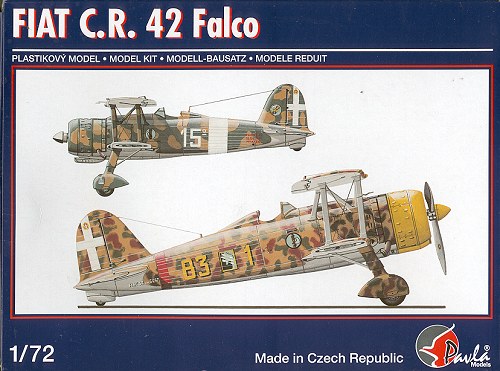
|
KIT: |
Pavla 1/72 Fiat CR.42 'Falco' |
|
KIT # |
72049 |
|
PRICE: |
$29.98 ($26.97 from Squadron) |
|
DECALS: |
Four options |
|
REVIEWER: |
Scott Van Aken |
|
NOTES: |
Short run with resin and vac parts |

|
HISTORY |
Naturally, with the experience gained by the designer Celestino Rosatelli with excellent biplanes like the CR.30 and the CR.32, also his CR.42 had excellent flying characteristics, so that even before waiting for the results of the official military tests, a first series of 200 CR.42s had been already ordered, a higher number than the Macchi C.200 or the Fiat G.50, but this could be attributed also to the various teething troubles experienced by the new monoplanes. The paradoxical result was that, whereas both the C.200 and the G.50 were out of production by mid-1942, the CR.42 was still in production in 1944, while Germany's new jet fighter Me 262 was already operational!
|
THE KIT |
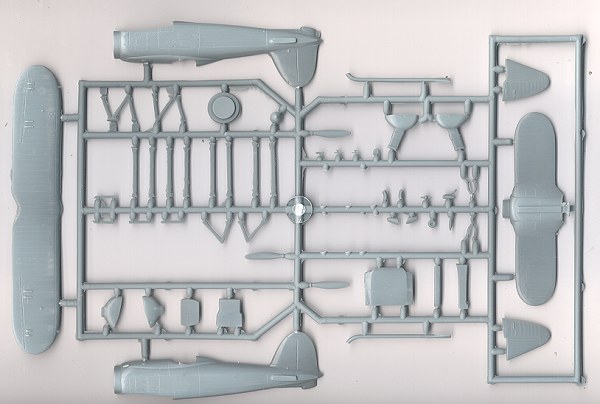
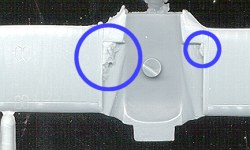 The kit is
molded in a medium grey plastic and is quite typical of Pavla's kits with
semi-large sprue attachment points, some flash on parts, and sink areas on
a few of the thicker bits. My kit also suffered from having some plastic
filling in the fillet attachment points on my lower wing. (see image to the
right) The large parts also have some ejector stubs to remove, the
ones in the forward cockpit area won't be easy as it covers some of the
interior wall detail. However, it is also probable that you won't be able
to see that section as the cockpit opening is quite small.
The kit is
molded in a medium grey plastic and is quite typical of Pavla's kits with
semi-large sprue attachment points, some flash on parts, and sink areas on
a few of the thicker bits. My kit also suffered from having some plastic
filling in the fillet attachment points on my lower wing. (see image to the
right) The large parts also have some ejector stubs to remove, the
ones in the forward cockpit area won't be easy as it covers some of the
interior wall detail. However, it is also probable that you won't be able
to see that section as the cockpit opening is quite small.
Allow me to fuss about having separate prop blades and a
resin hub. I'm not sure why this cannot be molded as one piece as I've seen
a lot of other kits do this in resin with no real problems. It surely makes
things 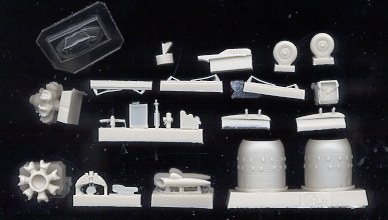 MUCH easier for the
builder. The rest of the resin parts are very well molded and constitute
most of the small bits that will go on the kit. The engine cowling is in
two halves, which makes clean-up of the seam quite difficult if one doesn't
want to eradicate the nice detail on it. Resin is also used for the
engine, wheels, seat bottom, bomb racks, sand filter, smoke generators and
various interior bits. It is also uses for the aileron and rudder controls,
but my set was missing one of the four sets shown in the instructions. Two
vac canopies are provided, a nice touch as I always end up messing one up.
MUCH easier for the
builder. The rest of the resin parts are very well molded and constitute
most of the small bits that will go on the kit. The engine cowling is in
two halves, which makes clean-up of the seam quite difficult if one doesn't
want to eradicate the nice detail on it. Resin is also used for the
engine, wheels, seat bottom, bomb racks, sand filter, smoke generators and
various interior bits. It is also uses for the aileron and rudder controls,
but my set was missing one of the four sets shown in the instructions. Two
vac canopies are provided, a nice touch as I always end up messing one up.
The instructions for Pavla kits are very well done and this
one is no exception. I did notice that the drawings are a bit lighter than
usual though it should cause no real problem. Several small bits will have
to be made from stretched sprue, including the long exhausts and cowl guns.
Though there are several options pro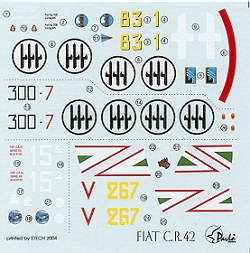 vided, there is no indication as to
which of the markings options they are matched with. If one goes by the
paint and decal drawings, there are few differences between the types other
than the use of the sand filter and the smoke generator (or are they
spotlight) looking things under the wings. Colors are coded to
Humbrol paints, but the generic name is also given in case you want to use
other brands.
vided, there is no indication as to
which of the markings options they are matched with. If one goes by the
paint and decal drawings, there are few differences between the types other
than the use of the sand filter and the smoke generator (or are they
spotlight) looking things under the wings. Colors are coded to
Humbrol paints, but the generic name is also given in case you want to use
other brands.
Markings are provided for four aircraft. First is the ubiquitous yellow cowled 1*83 from the 83rd Squadriglia in Belgium during the Battle of Britain. Next is a 15 Stormo aircraft based in North Africa. This one should probably have bomb racks though none are shown on the drawings. A night fighter version (which should have the long exhaust pipes and the underwing spotlight/smoke generator things) is from 167 Gruppo. It has the underside of the upper wing and the struts in black. Undoubtedly to prevent the normally lighter color of the underside camo from affecting his night vision. The last is a Hungarian aircraft with the early arrowhead insignia. Colors for all these planes are convoluted at best so I'll just say that painting all the mottles will be fun. Painting and decal instructions show top, bottom and both sides of each aircraft. The decals are well printed and should work superbly.
|
CONCLUSIONS |
I'm reminded quite a bit of the Mr. Kit kit of this plane by the general layout of the parts. Regardless, it won't be a shake and bake and is one that I'd recommend to those with some experience building short run kits and handling small resin parts. However, the end result can be a superb model with some careful building.
You can find this kit and many others at

If you would like your product reviewed fairly and quickly by a site that has over 250,000 visitors a month, please contact me or see other details in the Note to Contributors.